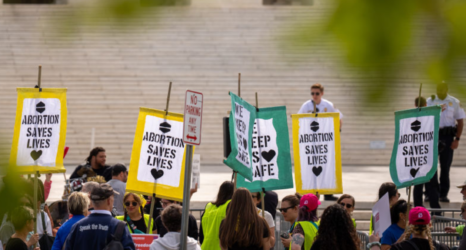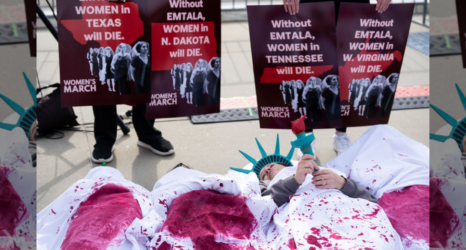Reprinted with permission from Health Affairs Blog
Over the past few months, legislative attempts to defund Planned Parenthood have flared at both the federal and state levels; these moves are clearly an attempt to shutter Planned Parenthood health centers, potentially depriving women of the contraceptive services and counseling, sexually transmitted infection (STI) testing and treatment, and breast and cervical cancer screening that they provide.
Although proponents of closing Planned Parenthood argue that other providers would be easily able to fill the hole torn in the safety net, credible evidence suggests this is unlikely. In some areas, Planned Parenthood is the sole safety-net provider of contraceptive care. And even where there are other safety-net providers, they, on average, serve far fewer contraceptive clients than do sites operated by Planned Parenthood.
As this debate swirls, the Guttmacher Institute received a request from the Congressional Budget Office (CBO) regarding the publicly supported contraceptive care provided by Planned Parenthood health centers across the country. To respond, Guttmacher staff conducted special tabulations of ourContraceptive Needs and Services 2010 report (the most recent year for which these data are available).
Our analysis shows unequivocally that Planned Parenthood plays a major role in delivering publicly supported contraceptive services and supplies to women who are in need of such care nationwide. In two-thirds of the 491 counties in which they are located, Planned Parenthood health centers serve at least half of all women obtaining contraceptive care from safety-net health centers. In one-fifth of the counties in which they are located, Planned Parenthood sites are the sole safety-net family planning center.
Further, the average Planned Parenthood health center serves significantly more contraceptive clients each year than do safety-net centers run by other types of providers, such as federally qualified health centers (FQHCs) or county health departments. As a result, Planned Parenthood centers serve a greater share of safety-net contraceptive clients than any other type of provider. And, Planned Parenthood sites are more likely to make contraceptive care quickly and easily accessible to the women who need it.
Contraceptive Care By The Numbers
Below are the key takeaways of Guttmacher’s findings related to Planned Parenthood’s provision of publicly supported contraceptive care.
Planned Parenthood health centers serve a considerable proportion of all clients obtaining contraceptive care from safety-net health centers.
In 2010, 36 percent of the 6.7 million U.S. women receiving contraceptive care from safety-net family planning health centers were served at Planned Parenthood centers. And there are some areas of the country where women rely particularly heavily on Planned Parenthood: In 18 states, Planned Parenthood health centers serve more than 40 percent of women obtaining contraceptive care from a safety-net family planning health center. In 11 of those 18 states, Planned Parenthood serves more than half the women obtaining contraceptive care from a safety-net health center.
Planned Parenthood health centers often serve most or all of the safety-net contraceptive clients in their county.
In 68 percent of counties with a Planned Parenthood site (332 counties out of 491), these sites serve at least half the women obtaining publicly supported contraceptive services from a safety-net health center. And in 21 percent of counties with a Planned Parenthood site (103 counties), Planned Parenthood serves all of the women obtaining publicly supported contraceptive services from a safety-net health center.
The majority of women who need publicly supported contraceptive care live in counties with a Planned Parenthood health center.
Almost two-thirds (64 percent) of the 19 million women in need of publicly supported contraceptive services and supplies live in counties with a Planned Parenthood health center. Moreover, 30 percent of these women live in counties where Planned Parenthood serves the majority of those obtaining publicly supported contraceptive care from the family planning safety net. (Women are considered to be in need of publicly supported contraception if they have ever had sex; are aged 13–44; are able to become pregnant; are not pregnant, postpartum, nor trying to become pregnant; and either have a family income below 250 percent of the federal poverty level or are younger than age 20.)
Planned Parenthood health centers serve a greater share of safety-net contraceptive clients than do any other types of providers.
Although Planned Parenthood health centers comprise 10 percent of publicly supported safety-net family planning centers, they serve 36 percent of clients who obtain publicly supported contraceptive services from such centers. By contrast, centers operated by health departments serve 27 percent of safety-net contraceptive clients, FQHCs serve 16 percent, sites operated by hospitals serve 8 percent, and sites operated by other agencies serve 13 percent.
On average, Planned Parenthood health centers serve many more contraceptive clients per year than do other types of safety-net providers. Planned Parenthood health centers serve an average of 2,950 contraceptive clients per year, many times more than any other type of publicly supported health center. By contrast, those operated by hospitals serve an average of 770 contraceptive clients, health departments serve an average of 750, FQHCs serve 330, and centers operated by other types of agencies serve 680 contraceptive clients each year.
Planned Parenthood health centers are more likely to facilitate women’s timely access to a wide range of contraceptive services and supplies.
Planned Parenthood sites are considerably more likely to offer a broad range of contraceptive methods than sites operated by other types of agencies. Specifically, 91 percent of Planned Parenthood health centers offer at least 10 of 13 reversible contraceptive methods, compared to between 48 percent and 53 percent of sites operated by other types of agencies.
Moreover, Planned Parenthood sites are particularly likely to help women who choose oral contraceptives to get their pills without having to make an additional trip to a pharmacy: 92 percent of Planned Parenthood health centers offer oral contraceptive supplies and refills on-site, as do 86 percent of health department sites. Considerably smaller proportions of sites operated by FQHCs and other types of agencies—37 percent and 55 percent, respectively—do so.
Finally, women are often able to get the care they need more quickly from Planned Parenthood than from other types of safety-net providers. Sixty-three percent of Planned Parenthood health centers offer same-day appointments, compared to between 30 percent and 40 percent of sites operated by other types of agencies. And the average wait for an appointment at a Planned Parenthood health center is 1.8 days, whereas wait times at sites operated by other types of agencies range from 5.3 to 6.8 days.
Looking Ahead
We cannot predict whether or to what extent health centers operated by other providers could fill the significant gap in the family planning safety net that would be created if Planned Parenthood health centers were defunded — and therefore lost to the communities they serve. Certainly in the short term, it is doubtful that other providers could step up in a timely way to absorb the millions of women suddenly left without their preferred source of care and whether those providers could offer the same degree of accessible, quality contraceptive care offered by Planned Parenthood. (Indeed, Texasoffers a cautionary tale; the state’s family planning program for low-income women served far fewer women after Planned Parenthood health centers were cut out of the effort.)
What we do know is that women nationwide rely on Planned Parenthood health centers for the contraceptive services and supplies they need — and for women in many areas of the country, losing Planned Parenthood would mean losing their chosen provider and the only safety-net provider around.
Photo via Shutterstock





